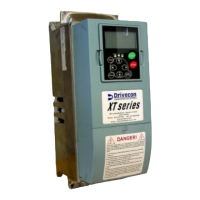Why is the Drivecon Controller load too high?
- AAngela RamirezSep 1, 2025
The Drivecon Controller load may be too high because the calculated motor torque is exceeding 30%. To resolve this, decrease the load.

Why is the Drivecon Controller load too high?
The Drivecon Controller load may be too high because the calculated motor torque is exceeding 30%. To resolve this, decrease the load.
What does it mean when my Drivecon XT DC Drives 'failed'?
If there is a general fault in the inverter or a motor set change during tuning, reset or stop the process. This indicates an incorrect operation based on keypad instructions.
What does a store failure mean on Drivecon XT DC Drives?
If writing to EEPROM failed, no solution is provided.
What to do if there is an output phase failure in Drivecon DC Drives?
If the current is not flowing in all three phases, check the motor cable connections.
What to do if the load is too high on my Drivecon DC Drives?
If the calculated motor torque is too high (more than 30%), the suggested solution is to decrease the load.
How to fix position error with Drivecon Control Unit when synchro functions normally?
If the synchro functions normally, and the master drive (V2.4.10.1) does not show a position error, but a position error occurs between the hooks, it may be because the system is not registering the position error because the nominal speed in one or more drives is not correct or accurate enough. Check P2.4.4 Nominal speed in all drives.
What to do if Drivecon Control Unit drives are vibrating after acceleration or deceleration?
If one or more drives are vibrating, especially after acceleration or deceleration, it could be due to a gain level that is too high, causing speed correction to overshoot. To fix this, reduce the P2.4.6 SystemBus Synchro gains value in the master drive. Reduce P2.4.6. SystemBus Synchro gains value in master drive.
| Protection Features | Overvoltage, Undervoltage, Short Circuit, Overtemperature |
|---|---|
| Communication Interface | Modbus RTU |
| Operating Temperature | 0°C to 40°C |
| Enclosure | IP20 |
| Storage Temperature | -20°C to 70°C (-4°F to 158°F) |
| Humidity | 0-95% non-condensing |
Procedure for checking inverter after unpacking and recording purchase details.
General safety guidelines for operating the inverter.
Steps and considerations for installing the inverter.
Required free space around the inverter for proper air circulation.
Guidelines for mounting the inverter and choosing an installation site.
Requirements for UL-approved copper cable and terminal tightening torques.
Procedures for checking insulation resistance of motor and mains cables.
Table specifying cable sizes and fuse ratings based on inverter model.
General guidance on cable installation for different inverter frame sizes.
Wiring diagram for XT Series Open Loop Traverse applications.
Wiring diagram for XT Series Closed Loop Traverse applications.
Wiring diagram for XT Series Open Loop Load Brake Hoist.
Wiring diagram for XT Series Closed Loop Hoist applications.
Detailed explanation of the inverter's operational functions.
Detailed explanations of EP, PO, AU, and MS control methods.
Pre-operation checks including connections and settings.
Essential checks to perform before initiating the first test run.
Procedure for testing the inverter with nominal and extra loads.
How to navigate and operate the inverter using the control keypad.
Process for editing parameter values using the keypad.
Parameters for monitoring fault occurrences and history.
List and descriptions of fault codes F1 through F6.
List and descriptions of fault codes F7 through F23.
List and descriptions of fault codes F24 through F45.
List and descriptions of fault codes F50 through F64.
List and descriptions of fault codes F65 through F74.
Recommended action to check and clear inverter fault history.
